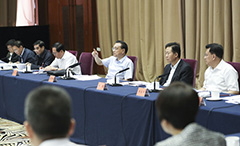Indicators show mixed economic performance
2018-11-15
China Daily
China’s major economic indicators put up a mixed performance in October, with industrial output and investment growth picking up while retail sales growth slowed, according to the National Bureau of Statistics on Nov 14.
Analysts said authorities may continue to take pro-active measures to shore up the economy in the coming months.
Industrial output in October grew 5.9 percent year-on-year, 0.1 percentage point higher than in September.
Fixed-asset investment growth was 5.7 percent in the first 10 months, up 0.3 percentage point compared with the first nine months. Private investment growth was 8.8 percent, 0.1 percentage point higher than the January-September period.
Retail sales growth weakened to 8.6 percent year-on-year in October, down from 9.2 percent in September.
Some indicators have pointed to a stabilization of economic growth amid economic restructuring as the world’s second-largest economy strives to be more fueled by high-tech industries, services and domestic consumption.
Manufacturing investment growth was 9.1 percent year-on-year in the first 10 months, 0.4 percentage point higher than in the first three quarters. Infrastructure investment rose to 3.7 percent in the January-October period, 0.4 percentage point higher than in the January-September period, the first rise this year. And private investment growth reached 8.8 percent over the same period, 0.1 percentage point higher than in the first nine months.
High-tech manufacturing output rose by 12.4 percent year-on-year in October, 1.2 percentage points faster than in September. Online sales increased by 26.7 percent in the first 10 months, much faster than overall retail sales growth.
“The October data show that economic growth is stable while the country continues with economic restructuring,” said Pan Jie, an Orient Securities analyst.
But there have been quite a few external uncertainties, such as cooling global economic growth, turbulent financial markets and fluctuations in commodity prices, said Liu Aihua, an NBS spokeswoman, at a news conference.
“Domestically, accumulative structural problems remain quite serious while some enterprises, especially small and medium-sized and private companies, still face many challenges in maintaining their operations,” she said.
Chinese policymakers have recently decided to cut taxes, ramp up investment in infrastructure, and facilitate financing of cash-thirsty private and small enterprises, among other measures, to stimulate the economy. GDP growth dipped to 6.5 percent in the third quarter, down from 6.7 percent in the second quarter and 6.8 percent in the first.
“The real economy still needs more fund inflows, as they have not improved much,” Zhongtai Securities said in a research note.
Analysts from the securities firm said the government is expected to further cut taxes and fees, and provide more support for local infrastructure construction through special debt issuance.


